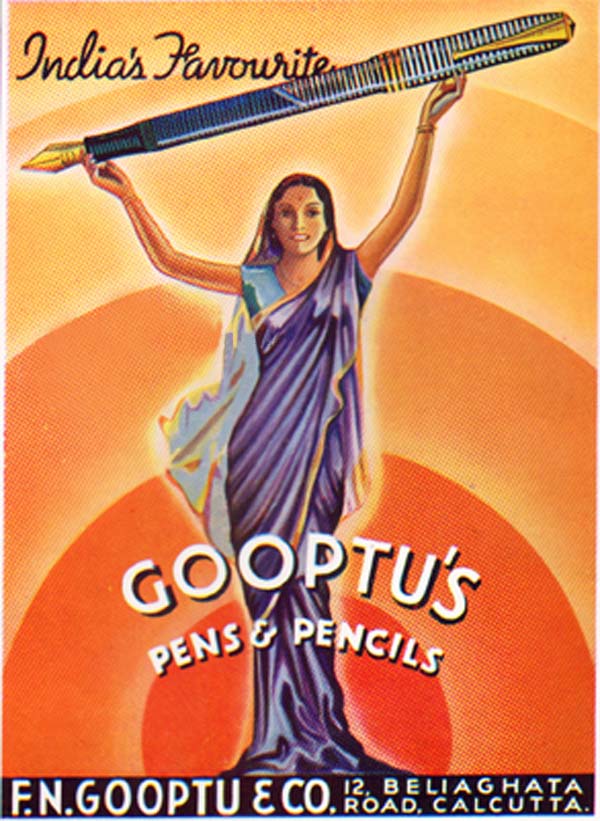
Gooptu. There is only one family that spells their surname with the double o’s. How or why the peculiar spelling was, and still is, resorted to, I do not know. But what I do know is that Dr Dwarka Nath Gooptu (1818 – 1882) was in the first batch of doctors to pass out from the Medical College Calcutta in 1836 and was a pioneer in western medicine. Refusing appointment as the Doctor to the East India Company, he set up private practice and developed his own pharmacy. He was the family physician of Prince Dwarka Nath Tagore, and was known to have accompanied him as ambassador for western medical education across India.

Dwarka had to his credit, a patented “mixture” that was administered to malarial patients. It was the largest selling medicine since the 1840’s, patented in an era when patents and trademarks were unknown. From Sri Ramakrishna to Tagore family members, all flocked to him for treatment. He was also an acknowledged educationist and was known for his insistence on full education for his family children.
Dr Gooptu’s grandson Fanindra Nath Gooptu was sent to England to acquaint himself with the then latest advances in trade, industry and commerce with a view to set up a business, which he did, establishing the firm F N Gooptu & Co in 1905. The product was pen-holders, in which, the firm was a pioneer in India. The business was started from one of the many Gooptu residences in erstwhile Calcutta, 5 Middleton Street. Inspired by the spirit of nationalism and friends like Dadabhai Naoroji, he rapidly moved to pencil manufacture. Then, after employing an American metallurgist, he developed nibs for pens and in-filling mechanisms.

It will not be out of place to recall here the fact that 1905 was the year of the Partition of Bengal, and “Swadeshi” was the popular buzzword, which perhaps explains the Swadeshi tag that FN Gooptu’s pen holders often come with. It is also said that F N Gooptu, a Presidency College alumnus, was a staunch Nationalist who, instead of plunging headlong into the freedom movement had set up the factory to further the agenda of self-reliance and contribute to the movement through other means. As a matter of fact, the Mahatma’s visit to the factory (1925) and his genuflection “It has been a great pleasure to me to be able to visit this pencil and pen holder factory. I was delighted to be informed some of the machines were designed and made in this factory. I wish this national enterprise every success.” corroborates this view, as does the fact that FN Gooptu was the spirit behind the “Bengal Initiative” which had the support of stalwarts like Acharya Prafulla Chandra Roy and off-course Naoroji.

Having studied the intricacies of the business himself – from manufacturing to marketing – FN Gooptu soon roped in the services of a second technologist from Europe, which had proved to be invaluable to the fledgling enterprise. As a matter of fact, so extraordinary was the success, that the factory was soon enlarged and the operations shifted to the then fringe of the city in Beliaghata from Middleton Street. The year was 1910.
The new factory was spread across six bighas (roughly 2.5 acres) of land in which all the machines were initially imported from England. FN Gooptu & Co grew rapidly thanks to the certification its pencils and pens received from a group of English and Indian I.C.S. officers, of whom the name of K. C. Dey is remembered even today.
FNG pens and pencils were widely used across India after the entity secured an annual contract to supply its products to the Imperial Government of India. The World War I (1914-18) had disrupted supplies of wood and metal, but when peace returned, users stuck to FNG products, thanks to the stringent quality norms that were maintained. As a matter of fact, even crashing prices of imports during the Great Depression 1929-39 did not undermine sales or profitability. German attack on British shipping in WW2 1939-45 proving to be a manna from the heavens, creating a monopoly of sorts.

The exact year in which FN Gooptu & Co made the transition into a fountain pen manufacturer is not known to me (though the fact that Gandhiji mentions only pencils and pen holders in his testimonial in 1925, would date the pens to a later period). Suffice to say, these pens – Gooptu’s Perfection – were of extremely high quality and came fitted with 14 carat gold nibs. Limited Editions with a Mother of Pearl finish were also available. As a matter of fact, some pens were made bespoke – for the babu’s of yore, which often had their names imprinted on the pieces.
But the truth remains – all this was way before Ratnamsons was established which junks the oft repeated claim that the first Swadeshi Pen was created down south. Both FN Gooptu & Co and the Luxmi Stylo Pen Works (in Varanasi) were established in and around 1905 giving them nearly three decades to have perfected their art before Ratnamsons came into being.

For some inexplicable reason, the Gooptu’s Perfection pens are extremely rare – it took me seven long years of search to finally own one – for most complete pieces are either with members of the family or with collectors who have no intention of parting with them. What is extremely sad is the little knowledge that is there in the public domain about the Gooptu’s Perfection pens and it is my ardent request to all to share any information pertaining to them that I may not possess, so that we may, at the very least, leave the facts behind for our successors to know about this glorious chapter of fountain pen making, Bengali enterprise and a quest for excellence.
(This piece has been edited by my senior, Ex Editor of the Business Standard Pradeep Gooptu, a member of the family and a resident of 5 Middleton Street, Kolkata, where it had all begun. I will fail in my duties if I do not mention the name of my dear friend and mentor, the Late Jayant Hirjee, who had first shown me a Gooptu’s Perfection and had encouraged me to dig up the history of the pen. Unfortunately, he left us before I could complete this piece. May his soul rest in everlasting peace.)

POSTSCRIPT:
Dr Sovan Roy, responding to the story wrote: “F. N. Gooptu’ s transition into a fountain pen manufacturer took place in 1911, much earlier than you are thinking. There is clear cut evidence of that. I have given that too, in the book (Radhika Nath Saha – the unsung hero of Indian Fountain Pen), Page 137”. Chandranath Chatterjee, collector of Kolkata memorabilia has been kind enough to provide images of a box that had housed Gooptu pens from his collection. I am grateful to both for the inputs.



Chawm, the history you furbished is really a treasure to cherish. Unfortunately, the Gooptu family failed to carry on the legacy.
Very interesting. So many things to know. Such an illustrious family.
Dear SG,
Extremely interesting to reada piece of history, thank you for sharing it.
Good to read,
Pitkar
So we’ll written and edited. My father Jayant Hirjee would have enjoyed it for sure.
i know…. he had even identified someone who had a whole pile of information that i could have used in the story.
Sanjay hirjee ,I’m happy ,sad to know so little about your dad whom I held in high esteem,btw,Dr Shantanu Gooptu, also happens to be a classmate, and Eye surgeon of repute,regards, freddy
Feel sad it does not exist anymore
I was looking for FN Gootpu’s pencils as part of my research on the Bengali enterprises. I am interested to know how the business declined and why it did so. Why FN Gooptu no longer made pencils, why no longer in business. This question is more important for me. Please inquire at your end.
it will be a pleasure to share whatever contacts / information that i have. there are pencil collectors who can also help you. please feel free to touch base for any help / assistance that you may need 🙂
You May Connect With Me
Excellent article and very informative. Just loved reading it.
Brilliant as usual, well scripted as are all your posts but enlightening for me to know that my next door neighbor and the family I have long known of manufactured pens in India. May i request you to find out if Pradeep Gooptu was in LA Martiniere as i think he was in school with me and we were friends as kids…..
sir, thank you. let me talk to Pradeepda and get back to you on this?
sir, he just confirmed. he is the one.
Good to know , other than PLATO in India Pen manufacturer was there .
As a collector of writing instriment proud to in India
1900 and earíer somebody was there to make pens.
Illustrious family indeed. Wonder why FNG brand did not expand and also does not exist today. Social contributions of FNG corporate entity must be existing even today for wider sharing with community.
F. N. Gooptu’ s transition into a fountain pen manufacturer took place in 1911, much earlier than you are thinking. There is clear cut evidence of that. I have given that too, in the book. Page 137.
Sovan Roy
This is a superb article. I have known of Gooptu’s primarily though YM’s collections, but this piece is very exhaustive.
I have been looking for a Gooptu’s perfection or the safety filler myself 🙂
Very interesting piece of history sir. Was a fascinating tidbit to read.
অনেক কিছু জানলাম
Amazing and interesting….a precious lost history.